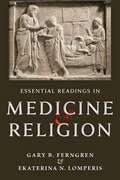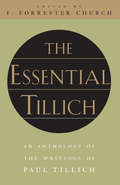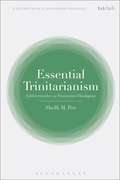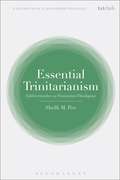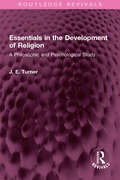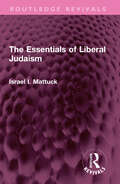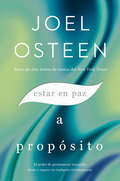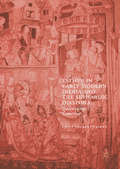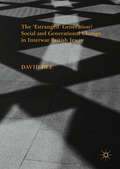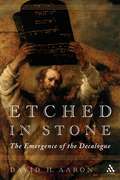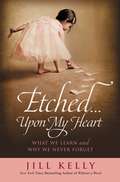- Table View
- List View
Essential Readings in Medicine and Religion
by Gary B. Ferngren Ekaterina N. LomperisGary B. Ferngren and Ekaterina N. Lomperis have gathered a rich collection of annotated primary sources that illustrate the intersection of medicine and religion. Intended as a companion volume to Ferngren;€™s classic Medicine and Religion, which traces the history of the relationship of medicine to religion in the Western world from the earliest ancient Near Eastern societies to the twenty-first century, this useful and extensive sourcebook places each key document in historical context.Drawing from more than 160 texts, the book explores a number of themes, including concepts of health, the causes and cure of disease, medical ethics, theodicy, beneficence, religious healing, consolation, and death and dying. Each chapter begins with an introduction that furnishes a basic historical setting for the period covered. Modern translations, some of which have been made especially for this volume, are used whenever possible. The texts are numbered sequentially within each chapter and preceded by a short introduction to both the author and the subject.Touching on Mesopotamia, Egypt, Israel, Greece, Rome, the European Middle Ages, Islam, early modern Europe, and the modern era, Essential Readings in Medicine and Religion brings a wide range of sources together to expand on the crucial lessons of Medicine and Religion. This book is a useful introduction for all students of history, divinity, medicine, and health.
Essential Tai Ji (PDF)
by Chungliang Al HuangFirst published over twenty years ago, this classic book distills the basics of the art of Tai Ji, lovingly presented in eloquent writing, and accompanied by splendid full colour photography and beautiful calligraphy. Master dancer, brush calligrapher, bamboo flute player and philosopher Chungliang Al Huang shares the basic movements of Tai Ji - and its relationships with nature, space and time - alongside stunning, inspirational photography by Si Chi Ko. The book promotes strength, relaxation and clarity, as Master Huang teaches how to unify mind and body, achieving a healthier and more fulfilling state of being. In doing so, he touches on everything from the origins and meanings if Tai Ji to the vocabulary, basic moves, practice, and the Tai Ji dance. This beautiful and inspiring book has an essential place in any Tai Ji library, and will be of interest to students, scholars, academics, professionals, and the general reader.
The Essential Talmud
by Adin SteinsaltzA masterful introduction to the to the great repository of Jewish wisdom, the TalmudIn The Essential Talmud, the renowned Israeli scholar and teacher Rabbi Adin Steinsaltz succinctly describes the history, structure, and methodology of the sacred text by which the Jewish people have lived and survived through the ages. Rabbi Steinsaltz summarizes the Talmud's main principles, demonstrates its contemporary relevance, and captures the spirit of this unique and paradoxical text as a human expression of divine law. This expanded edition features a historical overview of life in the times of the Talmud and an in-depth look at the content and appearance of the original Talmudic page. As Rabbi Solomon S. Bernards of the B'Nai B'rith Anti-Defamation League puts it, "this book is indispensable to those, Jews and Christians alike, who would like to gain an insight into what it is that moves the contemporary Jew."
The Essential Tillich
by Paul Tillich"With this volume, Paul Tillich joins the ranks of the great Christian theologians such as Augustine of Hippo and Thomas Aquinas. . . .This volume, compiled by a noted minister and scholar, offers to the theological student, church worker, or, indeed, any serious reader struggling with the existential question, a tantalizing and illuminating introduction to perhaps the greatest mind of twentieth-century Protestant theology."—Booklist "Church testifies to the power Tillich provides him for his pastoral work, his intellectual formulation and his personal life. He projects, quite properly, that the 'essential' Tillich can do the same for others. . . ."—Christian Century "This book summarizes in Tillich's own words much of the best of his thought, still highly relevant today."—Library Journal "[Church] helps Tillich speak to an audience unfamiliar with the breadth and depth of his thought."—Religious Studies Review
Essential Trinitarianism: Schleiermacher as Trinitarian Theologian (T&T Clark Explorations in Reformed Theology)
by Assistant Professor Shelli M. PoeMany scholars believe that Friedrich Schleiermacher relegates the doctrine of the Trinity to an appendix at the end of his magnum opus, The Christian Faith (1830/31); his alleged disregard for the Trinity is the supposed death knell for serious consideration of his work within the history of Christian thought.This volume argues that Schleiermacher not only calls for the doctrine's revitalization, but also makes it the centrepiece of Protestant Christianity. Following Schleiermacher's own thought experiment, Poe presents his doctrine of God in reverse order of its original presentation. Her examination centres on the Trinity, treating it as the keystone of the entire work, while analysing the divine attributes: love and wisdom, justice and holiness, eternity, omniscience, omnipotence, and omnipresence. When viewed from the standpoint of the conclusion, the Trinitarian shape of Schleiermacher's theology comes to the fore. What emerges is a middle way between merely economic Trinitarianism and a full-fledged development of immanent Trinitarianism, examining divine personhood and the union of the divine with humanity.The central thesis of this work runs boldly counter to the prevailing academic account of Schleiermacher's doctrine of the Trinity, and offers an innovative and constructive reading. Readers will be privy to a fresh look at Schleiermacher's doctrine of God and its importance for contemporary theology.
Essential Trinitarianism: Schleiermacher as Trinitarian Theologian (T&T Clark Explorations in Reformed Theology)
by Shelli M. PoeMany scholars believe that Friedrich Schleiermacher relegates the doctrine of the Trinity to an appendix at the end of his magnum opus, The Christian Faith (1830/31); his alleged disregard for the Trinity is the supposed death knell for serious consideration of his work within the history of Christian thought.This volume argues that Schleiermacher not only calls for the doctrine's revitalization, but also makes it the centrepiece of Protestant Christianity. Following Schleiermacher's own thought experiment, Poe presents his doctrine of God in reverse order of its original presentation. Her examination centres on the Trinity, treating it as the keystone of the entire work, while analysing the divine attributes: love and wisdom, justice and holiness, eternity, omniscience, omnipotence, and omnipresence. When viewed from the standpoint of the conclusion, the Trinitarian shape of Schleiermacher's theology comes to the fore. What emerges is a middle way between merely economic Trinitarianism and a full-fledged development of immanent Trinitarianism, examining divine personhood and the union of the divine with humanity.The central thesis of this work runs boldly counter to the prevailing academic account of Schleiermacher's doctrine of the Trinity, and offers an innovative and constructive reading. Readers will be privy to a fresh look at Schleiermacher's doctrine of God and its importance for contemporary theology.
Essentials in the Development of Religion: A Philosophic and Psychological Study (Routledge Revivals)
by J. E. TurnerFirst published in 1934, Essentials in the Development of Religion was written with the conviction that the psychological and philosophical analysis of all phases of religious experience, even those which may be accounted the highest, is capable of yielding results of inestimable importance which could be attained in no other way. Dr. Turner discusses the historical development of the philosophy of religion and reveals topics that have been presupposed or embodied in regular human life. The book will be of interest to students of philosophy, religion and psychology.
Essentials in the Development of Religion: A Philosophic and Psychological Study (Routledge Revivals)
by J. E. TurnerFirst published in 1934, Essentials in the Development of Religion was written with the conviction that the psychological and philosophical analysis of all phases of religious experience, even those which may be accounted the highest, is capable of yielding results of inestimable importance which could be attained in no other way. Dr. Turner discusses the historical development of the philosophy of religion and reveals topics that have been presupposed or embodied in regular human life. The book will be of interest to students of philosophy, religion and psychology.
The Essentials of Liberal Judaism (Routledge Revivals)
by Israel I. MattuckFirst published in 1947 The Essentials of Liberal Judaism explores the fundamental ideas of liberal Judaism. Rabbi Israel Mattuck explains that liberal Judaism is concerned not only with the question, where shall we find the teachings of Judaism, but also with the question, how shall we find them? He discusses important themes like conception of God in Judaism; grounds for the belief in God; problem of evil; guidance of God in human history; sin, repentance and atonement; Judaism and the social order; liberal Judaism and orthodox Judaism; differences between Judaism and Christianity and what it means to be a Jew, to argue that it is the fundamental principle of liberal Judaism that Judaism is a developing religion. This book is a must read for scholars of Judaism, history of Judaism, and religion.
The Essentials of Liberal Judaism (Routledge Revivals)
by Israel I. MattuckFirst published in 1947 The Essentials of Liberal Judaism explores the fundamental ideas of liberal Judaism. Rabbi Israel Mattuck explains that liberal Judaism is concerned not only with the question, where shall we find the teachings of Judaism, but also with the question, how shall we find them? He discusses important themes like conception of God in Judaism; grounds for the belief in God; problem of evil; guidance of God in human history; sin, repentance and atonement; Judaism and the social order; liberal Judaism and orthodox Judaism; differences between Judaism and Christianity and what it means to be a Jew, to argue that it is the fundamental principle of liberal Judaism that Judaism is a developing religion. This book is a must read for scholars of Judaism, history of Judaism, and religion.
Essentials of Shinto: An Analytical Guide to Principal Teachings (Resources in Asian Philosophy and Religion)
by Stuart PickenShinto is finally receiving the attention it deserves as a fundamental component of Japanese culture. Nevertheless, it remains a remarkably complex and elusive phenomenon to which Western categories of religion do not readily apply. A knowledge of Shinto can only proceed from a basic understanding of Japanese shrines and civilization, for it is closely intermingled with the Japanese way of life and continues to be a vital natural religion. This book is a convenient guide to Shinto thought.As a reference work, the volume does not offer a detailed critical study of all aspects of Shinto. Instead, it overviews the essential teachings of Shinto and provides the necessary cultural and historical context for understanding Shinto as a dynamic force in Japanese civilization. The book begins with an historical overview of Shinto, followed by a discussion of Japanese myths. The volume then discusses the role of shrines, which are central to Shinto rituals. Other portions of the book discuss the various Shinto sects and the evolution of Shinto from the Heian period to the present. Because Japanese terms are central to Shinto, the work includes a glossary.
The Essentials of Social Finance
by Andreas AndrikopoulosThe Essentials of Social Finance provides an interesting, accessible overview of this fascinating ecosystem, blending insights from finance and social entrepreneurship. It highlights the key challenges facing social finance, while also showcasing its vast opportunities. Topics covered include microfinance, venture philanthropy, social impact bonds, crowdfunding, and impact measurement. Case studies are peppered throughout, and a balance of US, European, Asian, and Islamic perspectives are included. Each chapter contains learning objectives, discussion questions, and a list of key terms. There is also an appendix explaining key financial concepts for readers without a background in the subject, as well as downloadable PowerPoint slides to accompany each chapter. This will be a valuable text for students of finance, investment, social entrepreneurship, social innovation, and related areas. It will also be useful to researchers, professionals, and policy-makers interested in social finance.
The Essentials of Social Finance
by Andreas AndrikopoulosThe Essentials of Social Finance provides an interesting, accessible overview of this fascinating ecosystem, blending insights from finance and social entrepreneurship. It highlights the key challenges facing social finance, while also showcasing its vast opportunities. Topics covered include microfinance, venture philanthropy, social impact bonds, crowdfunding, and impact measurement. Case studies are peppered throughout, and a balance of US, European, Asian, and Islamic perspectives are included. Each chapter contains learning objectives, discussion questions, and a list of key terms. There is also an appendix explaining key financial concepts for readers without a background in the subject, as well as downloadable PowerPoint slides to accompany each chapter. This will be a valuable text for students of finance, investment, social entrepreneurship, social innovation, and related areas. It will also be useful to researchers, professionals, and policy-makers interested in social finance.
The Established Church: Past, Present and Future (Affirming Catholicism)
by Mark Chapman Judith Maltby William WhyteThis book offers a definitive account of the recent history and theology of the establishment of the Church of England. Written in an accessible style and at the same time rooted in serious scholarship, it offers a range of views and opinions as well as an awareness of contemporary political and social problems. It asks a number of penetrating questions, including the key issue of the extent to which churches, and particularly the Church of England, can be protected from equality legislation, while at the same time expecting to have special political and social privileges. This issue relates to the thorny problems of the reform of the House of Lords, and even to the future of the Monarchy. While there is no effort to impose a particular agenda or solution, the book is nevertheless often provocative and suggests a number of ways forward for establishment. It is intended as a lively contribution to an often-overlooked debate, which has nevertheless become increasingly important in the multi-cultural context of contemporary Britain.
Estar en paz a propósito: El poder de permanecer tranquilo, firme y seguro en cualquier circunstancia
by Joel OsteenViva desde un lugar de paz abundante en medio de las preocupaciones y el estrés cotidiano de la vida con el autor número uno del New York Times y pastor de la Lakewood Church, Joel Osteen. Lo opuesto a la paz es la preocupación y el estrés. Ambos son ladrones que le roban el sueño, la alegría, la creatividad y las buenas decisiones. Si los deja entrar en su mente, incluso pueden mantenerlo alejado de su destino. Pero si aprende a cambiar sus respuestas automáticas a estas luchas y le entrega sus problemas a Dios, Él puede obrar en su vida. Si está cansado de vivir en tensión y ansiedad, entonces es hora de cambiar. En Estar en paz a propósito, descubrirá que usted no está diseñado para llevar la carga pesada por sí mismo: dé un paso atrás y deje que Dios intervenga. Encuentre la paz para que pueda dejar de preocuparse por su salud, su trabajo, sus finanzas o sus relaciones. La vida puede ser caótica a su alrededor, pero puede vivir arraigado en un espíritu tranquilo al recurrir a ejemplos de las Escrituras y las perspicaces experiencias personales de Joel para encontrar satisfacción. Aprenda cómo entregársela a Dios para que pueda superar sus expectativas.Live from a place of abundant peace in the midst of life's everyday worries and stress with #1 New York Times bestselling author and Lakewood Church pastor Joel Osteen. The opposite of peace is worry and stress. Both are thieves that rob you of your sleep, joy, creativity, and good decisions. If you allow them into your mind, they can even keep you from your destiny. But if you learn how to change your automatic responses to these struggles and give your problems to God, He can go to work in your life. If you're tired of living in tension and anxiety, then it's time to change. In Peaceful on Purpose, you will discover that you weren't designed to carry the heavy load yourself: step back to let God step in. Find peace so that you can stop worrying about your health, job, finances, or relationships. Life may be chaotic all around you, but you can live grounded in a calm spirit by drawing on scriptural examples and Joel's insightful personal experiences to find fulfillment. Learn how to give it to God so that He can exceed your expectations.
Esther in Early Modern Iberia and the Sephardic Diaspora: Queen of the Conversas
by Emily Colbert CairnsThis book explores Queen Esther as an idealized woman in Iberia, as well as a Jewish heroine for conversos in the Sephardic Diaspora in the sixteenth and seventeenth centuries. The biblical Esther --the Jewish woman who marries the King of Persia and saves her people -- was contested in the cultures of early modern Europe, authored as a symbol of conformity as well as resistance. At once a queen and minority figure under threat, for a changing Iberian and broader European landscape, Esther was compelling and relatable precisely because of her hybridity. She was an early modern globetrotter and border transgressor. Emily Colbert Cairns analyzes the many retellings of the biblical heroine that were composed in a turbulent early modern Europe. These narratives reveal national undercurrents where religious identity was transitional and fluid, thus problematizing the fixed notion of national identity within a particular geographic location. This volume instead proposes a model of a Sephardic nationality that existed beyond geographical borders.
Esther in Early Modern Iberia and the Sephardic Diaspora: Queen of the Conversas
by Emily Colbert CairnsThis book explores Queen Esther as an idealized woman in Iberia, as well as a Jewish heroine for conversos in the Sephardic Diaspora in the sixteenth and seventeenth centuries. The biblical Esther --the Jewish woman who marries the King of Persia and saves her people -- was contested in the cultures of early modern Europe, authored as a symbol of conformity as well as resistance. At once a queen and minority figure under threat, for a changing Iberian and broader European landscape, Esther was compelling and relatable precisely because of her hybridity. She was an early modern globetrotter and border transgressor. Emily Colbert Cairns analyzes the many retellings of the biblical heroine that were composed in a turbulent early modern Europe. These narratives reveal national undercurrents where religious identity was transitional and fluid, thus problematizing the fixed notion of national identity within a particular geographic location. This volume instead proposes a model of a Sephardic nationality that existed beyond geographical borders.
Esther Scroll: The Story of the Story (The Library of Hebrew Bible/Old Testament Studies)
by David J. ClinesThe book of Esther emerges from complex origins. According to David J. A. Clines, the story combines elements from numerous literary, textual, and storytelling traditions. Through the telling and retelling of the story, the book as it appears in the modern canon slowly emerges. In this volume, Clines uncovers this fascinating history by examining the literary and textual elements of the book, the shape of the story, and the shifts in meaning as new generations have retold the story and interpreted it for their own time.
Esther Through the Centuries (Wiley Blackwell Bible Commentaries)
by Jo CarruthersThis interdisciplinary commentary ranges from early midrashic interpretation to contemporary rewritings introducing interpretations of the only biblical book not to mention God. Unearths a wealth of neglected rewritings inspired by the story’s relevance to themes of nationhood, rebellion, providence, revenge, female heroism, Jewish identity, exile, genocide and ‘multiculturalism’ Reveals the various struggles and strategies used by religious commentators to make sense of this only biblical book that does not mention God Asks why Esther is underestimated by contemporary feminist scholars despite a long history of subversive rewritings Compares the most influential Jewish and Christian interpretations and interpreters Includes an introduction to the book’s myriad representations in literature, music, and art Published in the reception-history series, Blackwell Bible Commentaries
Esther Through the Centuries (Wiley Blackwell Bible Commentaries)
by Jo CarruthersThis interdisciplinary commentary ranges from early midrashic interpretation to contemporary rewritings introducing interpretations of the only biblical book not to mention God. Unearths a wealth of neglected rewritings inspired by the story’s relevance to themes of nationhood, rebellion, providence, revenge, female heroism, Jewish identity, exile, genocide and ‘multiculturalism’ Reveals the various struggles and strategies used by religious commentators to make sense of this only biblical book that does not mention God Asks why Esther is underestimated by contemporary feminist scholars despite a long history of subversive rewritings Compares the most influential Jewish and Christian interpretations and interpreters Includes an introduction to the book’s myriad representations in literature, music, and art Published in the reception-history series, Blackwell Bible Commentaries
The ‘Estranged’ Generation? Social and Generational Change in Interwar British Jewry
by David DeeThis book focuses on the nature and extent of social change, integration and identity transformation within the Jewish community of Britain during the interwar years. It probes the notion – widely articulated by Jewish communal leaders at this time – that the immigrant second generation (i.e. British and foreign-born children of Russian and Eastern European Jews who migrated to Britain in the late Victorian era up to the First World War) had ‘estranged’ themselves from their Jewishness, Jewish elders and peers and were fast assimilating into the British mainstream.The volume analyses the second generation’s developing outlooks and behavioural trends in a variety of environments, effectively charting the changes and continuities present therein. As a whole, the book sheds light on the varied ways in which this group developed new identities that both drew from and reflected their Jewish and British heritage.
Estranged Pioneers: Race, Faith, and Leadership in a Diverse World
by Korie Little Edwards Rebecca Y. KimChurches remain some of the most segregated spaces in the United States. In congregations that are multiracial, leadership can be a source of conflict. What does it mean for pastors of color to lead in multiracial spaces? Who are the pastors of color that serve as head clergy of multiracial congregations? What advantages do they have and what challenges do they encounter? How do they manage their role? How do their experiences compare to their white pastor counterparts who also head multiracial congregations? Drawing on data from a nationally representative comparative study of multiracial congregations across the United States, including more than 100 in-depth interviews, Estranged Pioneers both answers these questions and discusses the broader implications for community leaders in multiracial contexts. Korie Little Edwards and Rebecca Y. Kim make three primary arguments. First, pastors of color who lead multiracial congregations are estranged pioneers-they leave their familiar home churches to lead multiracial congregations, but often find themselves estranged from their old religious community as well as their new one. Second, compared to their white counterparts, they are better able to recognize pervasive white hegemony and also more easily cross cultural and racial boundaries, allowing them to reconcile norms from at least two cultures. Finally, Edwards and Kim argue that leaders of color can function as indispensable brokers who can bridge segregated racial networks. In a society that is increasingly diverse yet where segregation persists, they have the unique power and ability to function as bridges that connect otherwise segregated communities. Estranged Pioneers reveals how pastors of color are leading the way towards a more united multiracial future.
Estranged Pioneers: Race, Faith, and Leadership in a Diverse World
by Korie Little Edwards Rebecca Y. KimChurches remain some of the most segregated spaces in the United States. In congregations that are multiracial, leadership can be a source of conflict. What does it mean for pastors of color to lead in multiracial spaces? Who are the pastors of color that serve as head clergy of multiracial congregations? What advantages do they have and what challenges do they encounter? How do they manage their role? How do their experiences compare to their white pastor counterparts who also head multiracial congregations? Drawing on data from a nationally representative comparative study of multiracial congregations across the United States, including more than 100 in-depth interviews, Estranged Pioneers both answers these questions and discusses the broader implications for community leaders in multiracial contexts. Korie Little Edwards and Rebecca Y. Kim make three primary arguments. First, pastors of color who lead multiracial congregations are estranged pioneers-they leave their familiar home churches to lead multiracial congregations, but often find themselves estranged from their old religious community as well as their new one. Second, compared to their white counterparts, they are better able to recognize pervasive white hegemony and also more easily cross cultural and racial boundaries, allowing them to reconcile norms from at least two cultures. Finally, Edwards and Kim argue that leaders of color can function as indispensable brokers who can bridge segregated racial networks. In a society that is increasingly diverse yet where segregation persists, they have the unique power and ability to function as bridges that connect otherwise segregated communities. Estranged Pioneers reveals how pastors of color are leading the way towards a more united multiracial future.
Etched in Stone: The Emergence of the Decalogue
by David H. AaronThe document known as The Ten Commandments, more formally referred to as The Decalogue, remains among the most controversial and complicated passages in the Hebrew Bible. Even today, the twentieth chapter of Exodus continues to serve as a major religious and ethical icon within popular culture and religious communities, despite its many unexplained elements. Lawsuits over the display of Decalogue Tablets have occupied courtrooms in more than half the states of this country. And yet, few people understand that there is not one, but three versions of what are usually called "The Ten Commandments." Moreover, when their ideological underpinnings are examined closely, these versions prove to be quite antithetical to one another. Even fewer are aware of the probability that these documents were written very late in the history of biblical literature-indeed, so late as to constitute a literary afterthought in the development of Israelite ethnic self-definition. In Etched in Stone: The Emergence of the Decalogue Tradition, Aaron examines the question of when the Decalogue versions were written and why. The main focus of this book is the literary phenomenon known as "the tablets" and how it functioned within the broader narrative. Aaron argues not only that the inclusion of the Decalogue texts was quite late in the development of the Pentateuch's canon, but that their integration preserves vestiges of highly charged ideological conflicts that were inadvertently neutralized by the rather bland and generic ethical precepts coined among its verses. Etched in Stone provides a paradigm for merging a variety of critical methods (source criticism, tradition criticism, ideological criticism, redaction criticism) and literary approaches that have heretofore been under-explored. In this sense, Etched in Stone will be read by scholars for its far-reaching conclusions and used by students (undergraduates, seminary, graduate) for learning approaches to the sequencing of biblical materials.
Etched...Upon My Heart: What We Learn and Why We Never Forget
by Jill KellyOur lives are made up of moments. Some we hope to remember forever and some we long to forget. But it's the tapestry of these moments that come together to write the story God is telling through each of our lives. In ETCHED . . . UPON MY HEART, Jill Kelly shares some of the unforgettable moments in her life-some sorrowful, others filled with joy-as a "living epistle" to her daughters. Kelly's raw and honest reflections provide encouragement and inspiration for women and mothers who long to pass on hard-won knowledge of God's steadfast love and healing grace to their children. As she writes, "God will break our hearts, but He will hold the pieces. He will cradle us and redeem every tear we cry." Although great personal pain informs these pages, Kelly's story is ultimately one of forgiveness, reconciliation, and hope. Through the moments in time that Jill Kelly recounts, you will recognize the daily reality and eternal value of God's plan for your own life.
